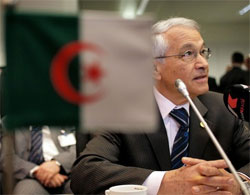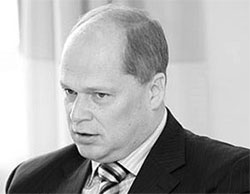Gaspec: too soon to start cheering
on
Gaspec: too soon to start cheering
Now that the dust has started to settle, not only from Icelandic volcanoes, but also from the latest Gas Exporting Countries Forum (GECF) meeting held in Oran, Algeria in mid-April, it has become clear that the outcome of the Forum was far from explosive. In fact, it barely failed to register on the ‘Richter scale’ as far as global gas markets were concerned. Gas production is not to be clipped any time soon, and plans to expand oil-indexation of gas contracts did not go beyond the rhetorical level. Gas remains a buyer’s market. Yet, this is no time for complacency on the side of consumers. Tightening the screw too hard might well lead to a price volcano outburst in the future.
 |
| Algerian Energy Minister Chakib Khelil |
While no one expected to see any kind of effective price collusion coming out of the most recent meeting in Oran, it has undoubtedly left Algeria with political egg on its face. Prior to the meeting, Algerian Energy Minister Chakib Khelil had been the one calling the loudest for production cuts on the spot market and indeed, had been keen to nudge the forum towards a more substantive cartel like arrangement. Clearly, this didn’t happen.
Instead, Qatar and Russia – the heavyweights of the gas world – allowed Algeria to painfully fall on its sword. Qatar stays fully intent on ramping up LNG production by more than 30% towards 77 million tonnes (104 billion m3) per year, having invested heavily in new trains since the early 2000s. What it can no longer sell into the US market now that the US has managed to ramp up its domestic production thanks to the development of unconventional gas, it will try and ship to Europe or out east to the Pacific Basin. Meanwhile Russia is hardly in a position to forego receipts from its gas exports, even as prices slump towards $4-5 per million British Thermal Units (Btu) on various spot markets – the lowest level since 2004.
Flip side
With producers keeping such a low profile and market constraints on cartelization looking more formidable than ever, this should come as very good news for consumers. But the risk of consumers overplaying their hands, while not immediately obvious, is actually becoming increasingly acute. If nothing else, the meeting in Algeria has signaled that the status quo is not one the gas producers can accept. Just like the Icelandic volcano, a major eruption could well be brewing, with the Oran meeting being merely the first small eruption.
On the face of it, this may sound far-fetched. The global gas glut is a reality, and it’s probably going to be with producers for some time, considering that shale gas, coalbed methane and LNG output have all hit the market at exactly the wrong time. The US market is not only saturated, it is exporting its new finds back into global markets. Asia has plentiful supplies of LNG all of a sudden, particularly with additional coalbed methane production being realized in Australia. More non-conventional production could certainly follow in countries such as Indonesia and India should initial estimates prove accurate. Even if GECF members wanted to push towards greater cartelization, this is hardly the time to try it.
But of course the flip side is that the exporting countries are increasingly backed into a corner. A number of commentators have already raised the obvious question just how low spot prices can go before producers are forced into some kind of supply side reaction. This is a good ‘starter for ten’, but it is ultimately the wrong question to put, for it’s already abundantly clear that spot prices can scrape the floor given low levels of spot market liquidity involved and money still being made on associated products without the majority of gas producers going into an economic and political spin. What is much less clear is how long prices can remain blunted at such levels before suppliers get nervous, and more importantly, if it paves the way towards further contract renegotiations breaking the oil index link on flagship pipeline projects. Arbitrage was supposed to be a game played by producers as gas markets tightened and cartel prospects looked rosy, not by pesky consumers negotiating down long-term Gas Purchase Agreements (GPA’s) towards lower spot prices.
A spot to watch
The fact that Qatar will be trying to sell much of its excess LNG supplies into European markets clearly doesn’t help in this respect. With European demand remaining weak, any additional supplies will inevitably create downward pressure on prices, and Algeria for one, doesn’t much fancy this prospect. Being cynical, we could of course argue that Algeria’s loss could prove to be Qatar’s and more credibly, Russia’s gain, if they manage to enhance their European market share. Going for broke by selling more gas to Europe (albeit on a cheaper basis) while dumping the entire cartel process certainly can’t be entirely discounted from Moscow’s perspective – just look at Putin’s recent South Stream tenacity as a good example. This pipeline project to bring gas from Russia to Southern Europe while circumventing Ukraine may look increasingly uneconomical, but Russia continues to push for it. However, we must be careful here not to confuse Russia’s unwillingness to absorb “opportunity costs” associated with a cartelization process with total indifference over price, not least because of the pressures weakening spot prices have been exerting on long term GPAs of late; this has the potential to hurt Russia considerably.
This is Russia’s real Achilles heel and it explains why Moscow has a major interest in arresting the decline of spot markets in order to keep its flagship pipeline projects alive. Russia does not care about the spot price per se, nor does it have a sense of responsibility to help keep its Algerian competitor in business (the Algerians will be selling gas into Spain from the Medgaz pipeline starting in July), but it needs to shore up Gazprom’s bottom line on its bread and butter pipeline supplies to Europe.
The snag for Russia is that if spot prices continue to slide, most consumers will try and take their chance to draw down prices further, particularly as most of them have already made maximum use of the flexibility provisions in their long-term contracts to obtain more spot gas. It doesn’t take all that much imagination for some of the downstream Nord Stream players, such as Eon and GdF, to reconsider whether paying $12 per million Btu from an oil-indexed link under current market prices, is the best way forward.
Feeling the pain
There is a catch, though: if consumers turn up the heat too quickly and for too long on gas producers, they stand a decent chance of finding that at subsequent GECF jamborees, it might not only be Algeria calling for supply restrains on spot and traded markets not covered by long term contracts. Tightening the screw too hard on producers could strengthen the political will of the exporters to recalibrate gas markets back towards safeguarding their interests. If they succeeded in restraining spot and traded markets, it would put the GECF back on a more credible footing as far as ‘price signals’ are concerned. Assuming Qatar sells much of its new LNG capacity under long term supply contracts, al-Thani would probably have relatively few qualms about putting a floor under spot prices to safeguard long term receipts. With the US currently ‘swimming’ in gas, pressures from Washington on its Gulf ally to resist such moves, would probably be less acute.
Whether all this would set the GECF on a genuine path to cartelization is of course a different matter – the structural difficulties to pull this off remain considerable and could get even bigger if the production of unconventional gas in Europe would take off as it has done in the US. This is even apart from the political fault lines running across the GECF and vexed questions of contracts, fragmented markets, quotas, or indeed who would really be able to play the role of a swing producer to control output across the cartel, given a pretty ‘elastic fringe’ of producers falling outside the body such as Australia.
 |
| Secretary General of the GECF Leonid Bokhanovsky |
If we put rising Asian demand in this mix, as well as the possibility that unconventional gas might still prove more expensive (and problematic) to produce than first imagined, then the market could start to look very different again. Gas supplies might not be as plentiful as consumers assume. If producers decide that setting a floor for spot prices becomes a politically more attractive option than allowing long term contracts to be revised in the interim, then the wheels towards greater supply side collaboration to drive prices as high as possible will be hard to stop. Admittedly, gas producers are feeling the pain now – and will probably feel it even more acutely in the months ahead as consumers make their move – but if they get through this period, and start applying their own painkillers along the way, they could still ultimately regain the upper hand in the future.
Perhaps the greatest irony here though is that Berlin and Paris haven’t got the stomach to drive through a really competitive gas market with respect to Russia. The fact that they don’t seem to want to squeeze Russia too hard might just prove to be Europe’s salvation in the long term: EdF’s recent 20% stake in the South Stream project certainly provides another pointer in this direction. If the Kremlin can muddle through, a gas cartel probably won’t come into existence.
| Matthew Hulbert is a Senior Fellow at the Center for Security Studies, ETH in Zürich. |


Discussion (0 comments)